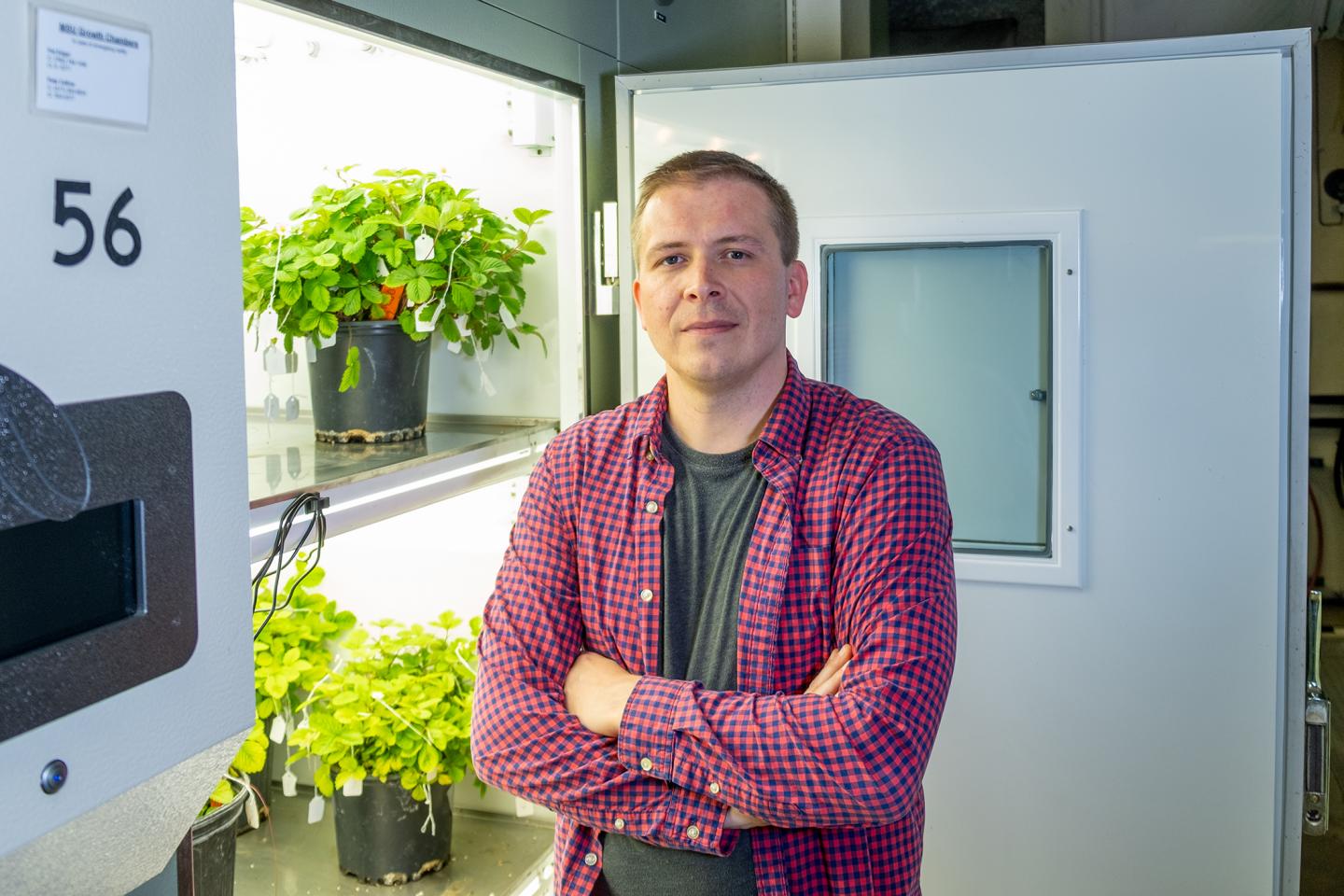
Credit: Courtesy of MSU
EAST LANSING, Mich. – Until now, little has been known about the evolutionary origins of the cultivated garden strawberry. Whereas most species, including humans, are diploid with two copies of the genome – one copy from each parent – strawberry is an octoploid, with eight complete copies of the genome that were contributed by multiple, distinct parental species.
In a new study published in Nature Genetics, researchers now unveil how the strawberry became an octoploid, as well as the genetics that determine important fruit quality traits. What researchers uncovered is a complex evolutionary history that started long ago on opposite sides of the world.
“For the first time, analysis of the genome enabled us to identify all four extant relatives of the diploid species that sequentially hybridized to create the octoploid strawberry,” said Patrick Edger, MSU assistant professor of horticulture and co-author on the paper. “It’s a rich history that spans the globe, ultimately culminating in the fruit so many enjoy today.”
These four diploid species are native to Europe, Asia and North America, but the wild octoploids are almost exclusively distributed across the Americas. The results presented in the paper suggest a series of intermediate polyploids, tetraploid and hexaploid that formed in Asia, prior to the octoploid event that occurred in North America, involving the hexaploid and a diploid species endemic to Canada and the United States. This makes the strawberry relatively unique as one of only three high-value fruit crops native to the continent.
Breeders began propagating these octoploids around 300 years ago. Since then, they have been used around the world to further enhance variety development. However, Edger hypothesized that — as with several other polyploids — an unbalanced expression of traits contributed by each diploid parental species, called subgenome dominance, would likely also be present in the octoploid strawberry. He was right.
“We uncovered that one of the parental species in the octoploid is largely controlling fruit quality and disease resistance traits,” Edger said. “Knowing this, as well having identified the genes controlling various target traits, will be helpful in guiding and accelerating future breeding efforts in this important fruit crop.”
The genomic discoveries provided by this study will advance the trait selection process, bringing about a more precise method of breeding for this important worldwide crop. The genome will enable studies that were previously unthinkable in strawberry, and will be a catalyst for tackling difficult breeding and genetics questions.
“Without the genome we were flying blind,” said Steven Knapp, UC-Davis plant scientist and study co-author. “I remember the first time I saw a visualization of the assembled genome, which went from a complex jumble of DNA molecules of 170 billion nucleotides to an organized and ordered string of 830 million base pairs. That was a special moment that changed everything for us in strawberry.”
Knapp said that, historically, scientists studying complex biological phenomena in strawberry have tended to focus on diploid relatives because of the complexity of the octoploid, even though genetic analyses in the octoploid are actually straightforward once one has a good road map.
“We have been on a crusade to shift the focus in the basic research community to the commercially important octoploid,” Knapp said. “The wild octoploid ancestors, together with cultivated strawberry, provide a wellspring of natural genetic diversity to support biological and agricultural research.”
Traditional breeding has been highly successful in strawberry, yielding outstanding modern cultivars that have been the catalyst for expanding production worldwide. As with other crops, many challenges remain that will require breeders to continually redesign cultivars and introduce genes from wild species and other exotic sources to meet new challenges. The genome is an essential vehicle for applying predictive, genome-informed approaches in strawberry breeding and cultivar development.
For the U.S., improved varieties could provide a boon to an already-thriving business. The U.S. is the global leader in strawberry production, a yield comprising roughly one-third of the world’s total. In 2016, the country produced more than 1.5 million tons.
The sequencing and analysis of the cultivated strawberry genome, exposing a wealth of new information about its origin and traits, is the product of an international team supported by Michigan State University AgBioResearch, UC Davis, the United States Department of Agriculture, the California Strawberry Commission and the National Science Foundation.
###
(Note to media: please include a link to the original paper in online coverage: https:/
Michigan State University has been working to advance the common good in uncommon ways for 160 years. One of the top research universities in the world, MSU focuses its vast resources on creating solutions to some of the world’s most pressing challenges, while providing life-changing opportunities to a diverse and inclusive academic community through more than 200 programs of study in 17 degree-granting colleges.
For MSU news on the Web, go to MSUToday. Follow MSU News on Twitter at twitter.com/MSUnews.
Media Contact
Layne Cameron
[email protected]
Original Source
http://go.




